IMPORTANT:
If you want to use information of this site,
please use a link to my page instead of copying parts of my pages.
In that way the information will be the most up-to-date! Please also read “About”
You can copy the URL or use this link to use on forums and such:
Hitachi – Y.S.S. (Yasuki Speciality Steel)
(Published: Sep. 6, 2016,
Updated: 2017, July, 2019, April, May)
Hitachi / Hitachi Metals Ltd., one of the top manufacturers of high grade metal
products, is well known for its “Yasuki Hagane”, “Yasuki steel”, or “Y.S.S.”
(Yasuki Speciality Steel). Yasuki steel has been produced in their plant in Shimane prefecture, Japan, where since ancient times high quality iron sand has been
produced for making traditional Japanese swords.
There are 3 main premium grade high carbon steels:
- Shirogami / Shiroko / White Steel (#1, #2)
- Aogami / Aoko / Blue Steel (#1, #2)
- Aogami Super / Blue Super Steel
There is also Kigami / Yellow Steel (#2, #3), which is of less quality then the previous ones
www.zknives.com
(Y.S.S. (Yasuki Speciality Steel) can be Kigami, Shirogami or Aogami)
Hitachi metal is also known for the production of high grade premium stainless steel, ATS-34 and ZDP-189
An amazing site, with the differences, easy explained:
hocho-knife.com/about-steel-qualities/
Or, with more detail:
japanesechefsknife.com/InformationAboutSteels
Y.S.S. ( = acronym of Yasugi Speciality Steel / Yasuki Speciality Steel, registered trademark)
It is said, that in 1995, 5 companies merged into “Hitachi Steel Co.”,
one of these companies was “Y.S.S.”
The history doesn’t seem to be that easy though…
History of Yasugi (Yasuki) Steel and Hitachi (hi means “sun”, tachi means “rise”):
Many types of industries prospered during the Meiji Period (1868-1912), and demand
for steel grew rapidly. Cheap European steel was imported to meet this need, while
the tatara business, unable to shift to mass production, found itself at a crossroads.
At the end of the 19th century, in response to this situation, five individuals who managed tatara in Okuizumo and Hoki established the Unpaku Steel Limited Partnership Company in a wholesalers’ district near Yasugi Harbor, and began to manufacture and sell tatara products. Yasugi Steel Manufacturing, which is the origin of the present-day Hitachi Metals Yasugi Works, was created as a result of this in 1899.
The Japanese economy sank into a deep depression after World War I. Unpaku Steel,
which now changed its name to Yasugi Steelworks, Co., eventually closed part of its factory in 1920. Yasugi Steel Manufacturing, which later becomes Yasugi (Steel)Works,
is merged by Tobata Foundry Co. in 1934, changed its name to National Production Corporation in 1935, and merged with Hitachi, Ltd. in 1937.
Hitachi itself is emerged out of many factories.
In 1910, Yamate Works was founded by Namihei Odaira as an electrical equipment repair and manufacturing facility. This facility was named Hitachi, after the Hitachi Mine near Hitachi, Ibaraki. It is regarded as the ancestral home of Hitachi, Ltd., which was incorporated as an independent company in 1920. Odaira acted as the Managing Director of Hitachi from 1910 to 1929 and the President from 1929 to 1947. (Link)
Yamate Works, together with 2 younger factories, Kaigan Works and Rinkai Works, became Hitachi Works (the oldest member of the Hitachi Group)
Also in 1910, Tobata Foundry Co., which later became Tobata Works, is established. Tobata Foundry Co. changes its name to Kokusan Industries, Ltd. in 1935, and was purchased by Hitachi, Ltd. in 1937.
In 1956, Hitachi, Ltd. transfers its metals business and five works (Tobata, Fukagawa, Kuwana, Wakamatsu, and Yasugi) to Hitachi Metals Industries, Ltd. The steel division of Hitachi, Ltd. was thereby split off to form Hitachi Metals.
The city of Yasugi, Shimane Prefecture, is still home to the Hitachi Metals Yasugi Works.
As far as I know, and understand, Yasuki (Steel) Works merged with Hitachi, Ltd. in 1937, so razors with Hitachi and Y.S.S. or Yasuki symbols would be younger then 1937.
For more and deeper insight, see:
https://en.wikipedia.org/wiki/Namihei_Odaira hitachi-metals/tatara
https://en.wikipedia.org/wiki/Hitachi
http://www.hitachi-metals.co.jp/e/ir/pdf/ar/2014/2014_62_63.pdf
http://www.hitachi-metals.co.jp/e/corp/corp03.html
http://kouru1.tripod.com
http://www.wakou-museum.gr.jp/en/
YSS is still used in modern times, for example in automobiles:
http://www.hitachimetals.com/Steering_Brakes
Y.S.S. – Yasuki Speciality Steel
There are different symbols, trademarks, to be found, together with YSS:
- 45 HARD SOLFEN M.O.C. H.Y.S.2.7. (H.Y.S. being “Hitachi Yasuki Steel”)


- YSS 63 ヤスキレーザーH.CO.,LTD., Yasuki Y.S.S. Razor



ヤスキレーザー H.CO.,LTD. = ヤスキ = Yasuki, レーザー = razor
⇒ Yasuki razor Hitachi Co.,Ltd.
取締役社長 中村隆一 = Torishimariyaku shachō nakamura ryūichi
⇒ President/Managing director Ryuichi Nakamura (?)) - S·L TRIUMPH, YSS 431 ヤスキレーザーH.CO.LTD., Y.S.S.
= Yasuki razor Hitachi Co.,Ltd., Yasuki Speciality Steel)



- S·L Yasuki Special Steel ヤスキ razor, YSS 472 ヤスキレーザーH.CO.LTD.
Yasuki Y.S.S. Razor



- Yasuki No.100, Yasuki Y.S.S. Razor









理容科研創制 = Riyō Kaken Sō-sei = Barber Research Institute System
理容科研, Barber Research Institute, is also seen on “R. Saito” razors,
see R. saitō – KRG – Ribbon Co.) - Y.S.S. No. 200 サイコー (= saikō), Yasuki 61.A2.36 (not sure of the 61),
with a Tamahagane symbol 玉鋼, Yasuki Y.S.S. Razor



- Yasuki 61.A2.36, 1072 KAINA 腕 (= Kaina), Yasuki Y.S.S. Razor



- S·L TRIUMPH YSS 1072 ヤスキレーザーH.CO.LTD., Yasuki Special Steel



- YSS Yasuki Razor, KRG


KRG → See R. saitō – KRG – Ribbon Co.
Other symbols, kanji, related to Hitachi:
H.Y.S.2.7. (H.Y.S. = “Hitachi Yasuki Steel”)


H.Y.S.2.7. (on a “宝剣66” – “Hōken” Western Japanese razor)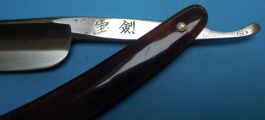

H.Y.S.2.7.5 (on a “宝剣66” – “Hōken” Western Japanese razor)




H.Y.S.2.7. “TSC” (on a “宝剣66” – “Hōken” Western Japanese razor)
![]()
![]()
![]()
![]()
![]() 手打レーザ 日立ヤスキ鋼
手打レーザ 日立ヤスキ鋼

手打レーザ ; 手打 = teuchi, レーザ = rēza ⇒ handmade razor
日立ヤスキ鋼 ; 日立 = Hitachi ; ヤスキ鋼 = Yasuki steel ⇒ Hitachi Yasuki steel
(Update: 2019, April)


日立ヤスキ鋼 ; 日立 = Hitachi ; ヤスキ鋼 = Yasuki steel ⇒ Hitachi Yasuki steel
an airplane (“Sword Stroke Comet”). It was a rocket-based fighter developed
The design was started based on the material of the German Air Force’s
Messerschmitt Me 163, but it ended with a prototype. (7 were made, 1945)
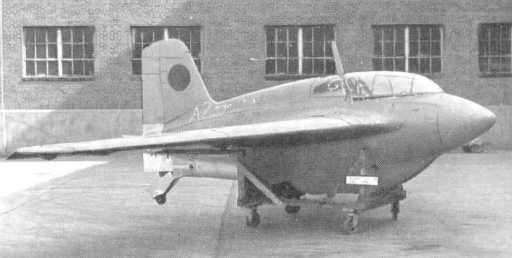
(Update: July ’17)
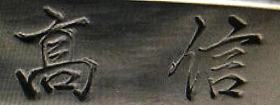

高信 = “Takanobu”
The ヤ symbol in the circle I believe is “Yasuki”, from:
= > Hitachi Yasuki Factory Forged
(Update: May ’19)
Tamakō YSK Razor
(Tamakō = Tamahagane
YSK = Yasuki)
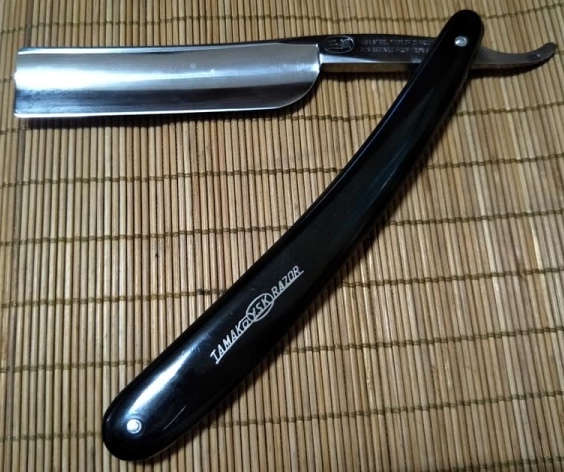
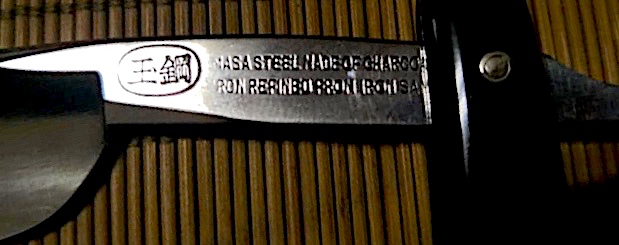
玉鋼 = Tamahagane (Tamakō)
“Masa Steel Made Of Charcoal
Iron Refined From Iron Sand”
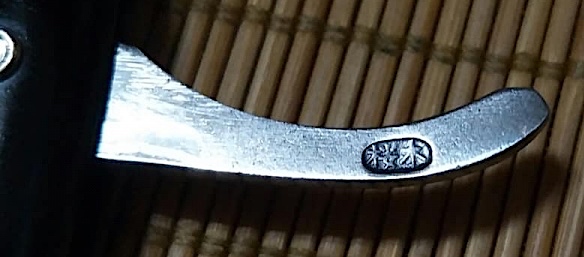
櫻木:Sakuragi
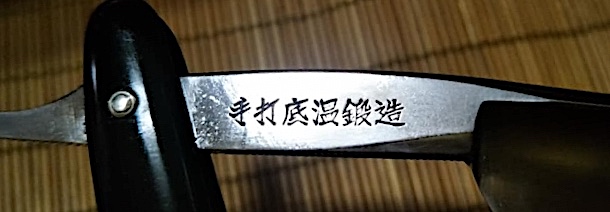
手打底温鍛造 = Teuchi soko Yutaka tanzō = Low temperature hand forgedsharprazorpalace.com/Japanese Straights
(Update: July ’17)
日立焼鈍鋼 = Hitachi shōdon-kō = Hitachi annealed steel
大師 = Daishi



“大師” = Daishi = means “great teacher”,
日立焼鈍鋼 = Hitachi shōdon-kō = Hitachi annealed steel
高橋 = Takahashi (Master)
Annealing, in metallurgy and materials science, is a heat treatment wherein a material is altered, causing changes in its properties such as hardness and ductility. It is a process that produces conditions by heating to above the critical temperature, maintaining a suitable temperature, and then cooling. Annealing is used to induce ductility, soften material, relieve internal stresses, refine the structure by making it homogeneous, and improve cold working properties.
Read “Annealing (metallurgy)” on English Wikipedia
(Update: July ’17)
There always be a discussion if “Yasuki steel” is “Tamahagane”
Yasuki steel isn’t Tamahagane if you consider Tamahagane in the sense of traditional steel of which the antique katana were made. Still, Yasuki steel is made from iron sands like tamahagane… Yasuki steel is differently made though and is considered “industrially made” Tamahagane, unlike the traditional process in which Tamahagane was/is made.
So, technically Yasuki steel isn’t traditional Tamahagane, but it is the same type of steel, maybe even better (more refined).
Confusingly, the “Hitachi company” does not advertise “Yasuki steel” as “tamahagane”, but some blacksmith call it “Tamahagane” on their own as a reference to the purest steel they can buy that is similar in “spirit” to the old sword steel. (badgerandblade.com)
It is considered that Yasuki steels that were thought of as tamahagane were always
the #1 white paper steel (#1white steel) because it was the finest grain and the purest formula without the additives that blue paper steel (#1 or #1blue steel) has.
Here is an example of a DAISHI “Yasuki steel” razor, made of iron sand






As you can see, there is written “Tamahagane R.K Co.”,
a company name which make things more confusing…
Even more confusing is this:
“Tamakō Y.S.K. razor”:
“Masa steel made of char…” – “Iron refined from iron (sand)”
(Masa steel is a kind of iron sand (katana-craft.com/tamahagane-steel))


手打底温鍛造 : Low temperature hand forge
 “kō” = “hagane”,
“kō” = “hagane”,
so “Tamakō” should be “Tamahagane”, also there is the “Tamahagane” symbol 玉鋼,
but this could be the “name” of the company…
The Y.S.K. would refer to “Yasuki Steel…”
Together with previous shown
“Y.S.S. No. 200 サイコー (= saikō), Yasuki 61.A2.36 (not sure of the 61)”,
with a Tamahagane symbol 玉鋼, Yasuki Y.S.S. Razor



It isn’t always easy to separate “Yasuki” from “Tamahagane”…





Found a Marvel Electrician’s knife (Japanese brand) which I had the stamping translated to say Hitachi, yasuki hagane. Can send in pictures to be posted if you want.
LikeLike
Hi,
Yes please, I would like that!
Thank you very much!
LikeLike
Pingback: Bōsō 房総 | Fikira